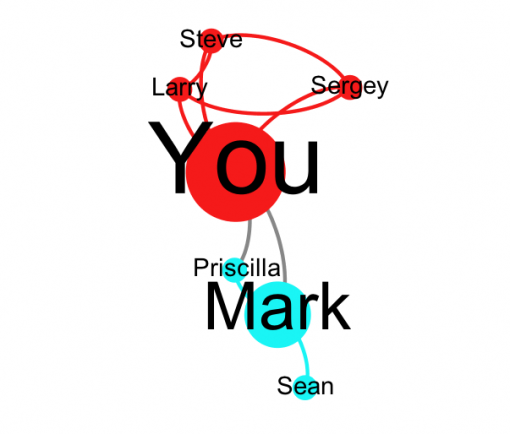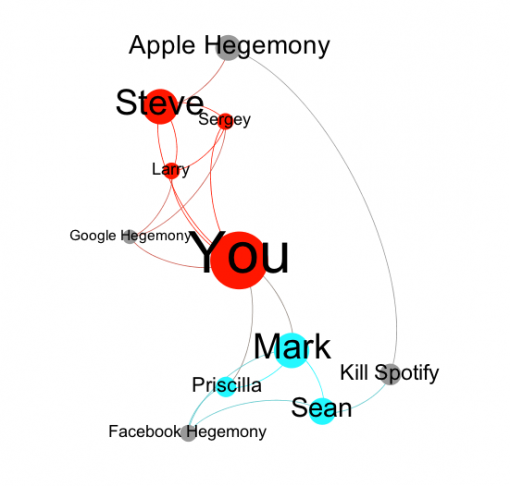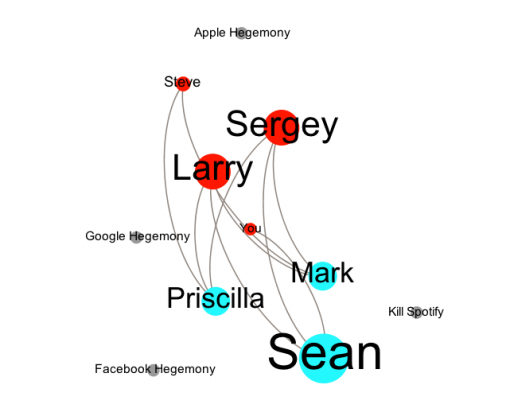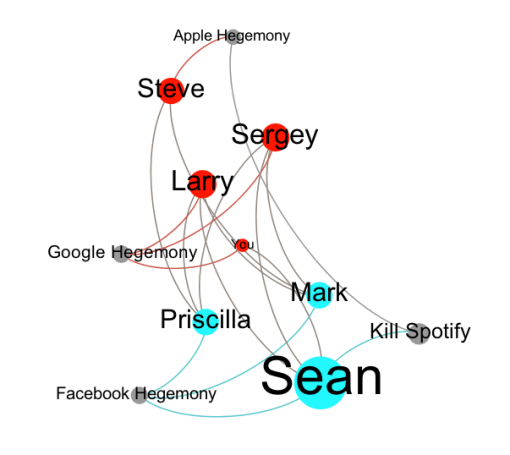Posted by Nodus Labs | May 29, 2012
Polysingularity within Socio-Cognitive Networks
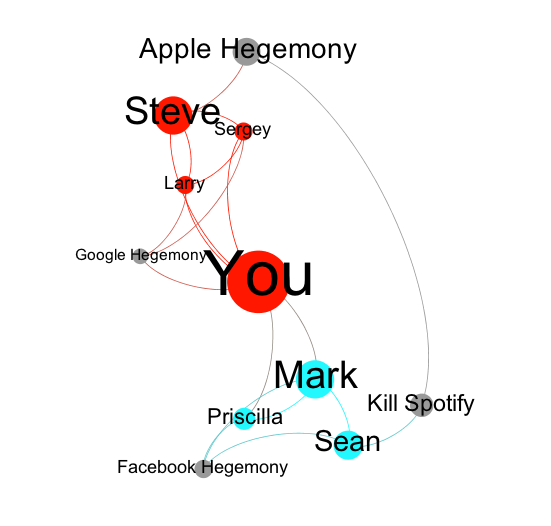
Polysingularity is a practice of maintaining several dynamic singularities at once. Within social context this implies the existence of several communities, which are segregated enough to operate independently from one another, but are sufficiently integrated in order to be able to synchronize on the global level. Together with specialists from Transnomia Institute we developed a social experiment that allows participants to experience polysingularity in a protected social setting.
Project: workshop “On Discord” for Agora Collective
Objective: show how the framework of network analysis and principles of polysingularity can be used to brainstorm new ideas, reach decisions, open up discussions, and generate solutions in social environments
In our previous research paper on “Inclusive Exclusivity” we’ve shown how polysingularity can be beneficial for maintaining innovative drive within a community. The basic idea is that the people at the periphery of one subgroup (those, who don’t have too many connections) should be linking to the people at the periphery of their own subgroup and to the periphery of the other subgroups within their community. This way they will be able to increase their influence in the network and also keep the network at large open to the new ideas. The most connected people, or the hubs, should decrease their influence in the groups that they are well-connected to and seek to extend their interactions into the other groups, bridging connections with the medium-sized local hubs there. Such dynamic connectivity pattern insures, on the one hand, a social structure that’s constantly evolving, and, on the other hand, that influence is distributed more equally across the people in the community.
In order to illustrate this dynamics better, we can use the framework of network analysis. The nodes in this case are the people, and the connections are interactions between them. The strength of connection can encode the frequency of interactions over a time period, physical proximity, the number of shared beliefs, and so on. Polysingularity in this case can be represented as a continuous change of the network’s community structure: the old constellations break apart, the new ones emerge, the nodes at the periphery of the network connect, the hubs are seeking other groups and nodes to connect to outside of their immediate surrounding.
What emerges are the islands of non-equilibrium stability. Each of them is distinct in its specificity and yet the connections between these islands allow them to communicate and synchronize to fulfil the global agenda. For example, within social context that would mean that we always have several groups each responsible for generating a certain kind of agenda different from the others. However, these groups are able to interact and exchange their ideas with one another.
Practically, this is a hard task. There is strong conditioning in our social interactions: we tend to organize in tightly-knit cliques of close friends or colleagues, the people who have a lot of connections tend to communicate more often with those who are also very well connected, we tend to organize in circles based on our interests, social network tools we use, such as Facebook, help us stay within the informational bubble. Random connections are not easy to make and the social contexts created for that lack in proposing a clear way of relating to one another that is different from the already established habits.
This is the reason we developed a practical step-by-step process designed to introduce the principles of polysingularity into collective interactions. First, the participants are invited to map out their existing social network. The nodes are the people and the connections represent the intensity of their interactions during the last month. For example, if the participants are yourself, Larry, Steve, and Sergey (all of who know each other), on one side, and Sean, Mark and Priscilla, on the other, and the only connection between the two groups is that you know Mark and Priscilla, the resulting image will look something like this:
The bigger nodes are the ones that are more influential: they have more connections and bridge the two communities together – in this case it’s you and Mark. There is a more detailed explanation of network influence dynamics in our previous case study. In short, polysingularity of social relations would imply continuous redistribution of influence across the nodes. This can only be achieved if the nodes make the new connections and get rid of the old ones. The choice should not be dictated by social norms. For instance, we’ve shown in our case study of influence, that Sean’s first impulse to become more influential would be to connect to you, however, this just increases your influence, but not Sean’s. Instead, we showed that by increasing the density of connections within one’s own group while bridging the links with the less connected (but unique) nodes in the other group, Sean can increase his influence rapidly, while also decreasing the influence of the most powerful hubs and increasing the influence of other peripheral nodes.
If this process is continuous, then we’ll have a constantly iterating system where the new connections are bridged, the new ones are abandoned, the network’s structure evolves, it is open and receptive to the new influences.
Once the social network of the participants is mapped, we can map the network of their ideas on top of the initial social structure. For instance, let’s assume that Sergey and Larry say they want total Google hegemony, you side with them, Steve wants Apple to take over, Mark, Priscilla and Sean prefer that the world is dominated by Facebook, but Sean also wants to kill Spotify (to revenge for Napster) – an idea that’s kind of related to Steve’s goal. The resulting social-cognitive network would look something like this:
As we can already see, Steve is quite influential in this new constellation, as his idea is the only one that kind of intersects with another idea within this network. He’s also well-connected to the first group, meaning he could probably exert some influence on them. However, you, as the most influential hub, support the idea of Google hegemony, so it’s not going to be an easy fight. We can predict, nevertheless, that this initial social constellation will probably give preference to the idea of Apple Hegemony as it is shared by a relative influential person from the first group and can also be indirectly supported by Sean from the second group, because it helps him reach his goal of killing Spotify.
The next step in our experiment is to host a discussion of these topics within a totally different social constellation. That is, the main hubs move to the periphery, and the peripheral nodes become the hubs. We achieve this by proposing a simple rule: for one hour we will be discussing these topics, but in the way that Mark can only be talking to Steve, Larry or Sergey (because they are not connected and belong to the different groups), Priscilla can only speak to Steve, Sergey, and Larry, you are allowed to interact with Sean only, who, in turn, is allowed to speak to Sergey or Larry. Steve can only communicate with Mark and Priscilla, and Sergey and Larry cannot communicate to one another. Therefore, each person follows a pattern that is completely different from their natural tendencies and past experiences. In order to make it easier to fulfil this rule, a large space can be used, so that those who are talking together can organize themselves in circles and move away from those they are not allowed to communicate with. The resulting network will look something like this:
That is, we temporarily create a kind of situation where those individuals who used to exert a lot of influence over the network will lose it, while those who were at the periphery gain more influence. At the same time, all the nodes belong to the same component, so ideas can still flow from one individual to another, it’s just that the pathways will now be different for a while.
As the final stage we sit together again at the table and discuss the outcomes of this interaction. We question each participant again if they have any new ideas and what their views are on supporting the old ones they had. Supposing that there were not ideas emerging from this interaction (rather, the participants discussed the already existing ones and clarified their points of view on them), the resulting network would look something like the graph below:
In the previous social constellation the idea of Apple Hegemony seemed like the most viable one (at least it had more chances to be indirectly supported by the both groups). In the new constellation it becomes least likely of all to be supported. Therefore, we achieved polysingularity on the cognitive level through changing the social structure: the more prominent ideas lose their importance, while the less prominent (but still influential ideas) are given a better chance for survival.
The outcome of this interaction will be decided by the group, but we wanted to demonstrate the practical application of polysingularity principle to diversifying the socio-cognitive field in order to help interaction flow in a way that is more flexible than the standard social constellations imply.

